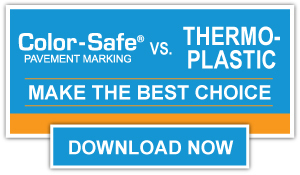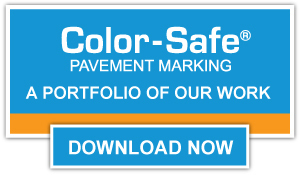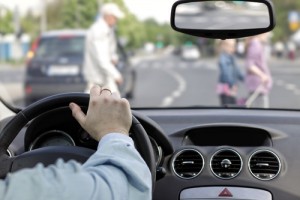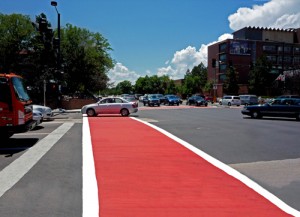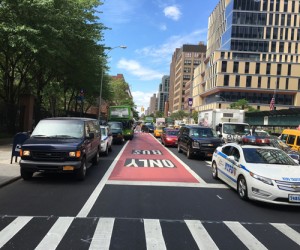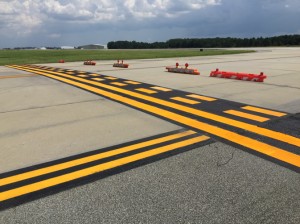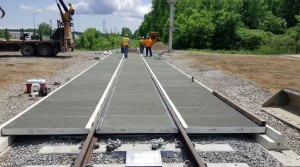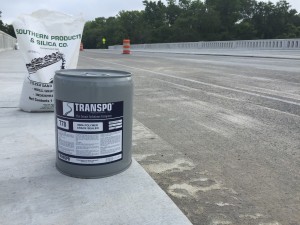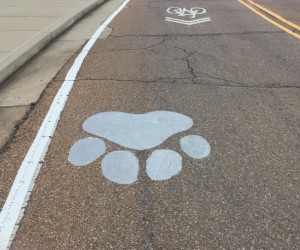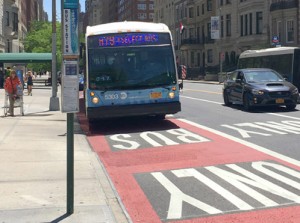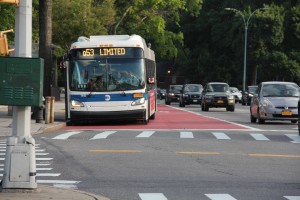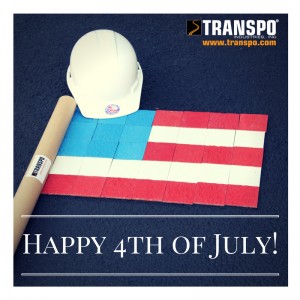
Karen Dinitz
Color-Safe® Bus Lanes
Red Color Now Approved by FHWA for Bus Lanes!
Transpo is proud to announce that Color-Safe® is being used for bus lane demarcation in both New York City and Chicago. These are two major cities that the Federal Highway Administration (FHWA) approved for optional use of red color markings on city streets to signify bus priority lanes. Given the positive track record the bright green bike lanes have had in the past decade, this is a welcomed advancement for cities and towns that want to improve traffic movement and deter bus accidents. These dedicated lanes will also help make service more efficient and increase reliability.
“APTA believes in innovation, and implementing new technologies is vital to helping ensure public transit riders, pedestrians and drivers remain aware and safe—the use of different color lanes is one of those innovations.” – Chad Chitwood, spokesperson for the American Public Transportation Association (APTA), interview with Smart Cities Dive
Color-Safe® Durable Pavement Markings are the most cost-effective, high-definition color markings on the market today.
Cold weather applications extend the marking season, and with the long life cycle of Color-Safe®, transportation officials look at methyl methacrylate (MMA) as the optimal material for special-use lane marking material. It is capable of full cure in a wide range of temperatures—down to 40°F—and adheres to both concrete and asphalt surfaces.
MMA symbols and striping develop a strong bond to existing MMA, making Color-Safe® a viable alternative to thermoplastic markings.
Color-Safe® Bike Lanes
Safer Streets for All Road Users Is a National Effort!
Vision Zero strategies aim to eliminate all traffic fatalities and severe injuries while increasing safe, healthy, equitable mobility for all. This has become a global mission, and we are proud that our products support effective strategies that help keep people safe.
Green-colored bike lane surfacing is a safety feature that communicates to road users that a portion of the roadway has been set aside for preferential or dedicated use by bicyclists. It also serves as a continuous reminder to drivers of the possibility of the presence of bicyclists as they merge or change lanes.
Color-Safe® Durable Pavement Markings are the most cost-effective, high-definition color markings on the market today. This innovative system can be combined with various aggregates according to application needs, making application easy and the green surface durable—able to withstand bike traffic and vehicular traffic when in multi-use areas.
Color-Safe® MMA resin component is capable of full cure in a wide range of temperatures, therefore extending the marking season and increasing productivity.
Color-Safe® is applied in a single application. No special spray, mixing equipment, or heat is required for installation. MMA symbols and striping develop a strong bond to existing MMA, so look to Color-Safe® as a viable alternative to thermoplastic markings on both concrete and asphalt surfaces.
Additional Applications
- Bus Lanes and Stops
- School Zones
- University Campuses
- Emblems and Mascots
- Intersections
- Roundabouts
- Walking Paths
- Pedestrian Plazas
- Toll Lanes
- Speed Zones
- Turns and Curves
- Hazardous Road Areas
- Industrial Facilities
- Airfield Marking
Transpo Industries, Inc. manufactures and distributes a variety of innovative products and materials designed to improve road safety. Transpo’s reputation as an expert in roadway safety has made Transpo a leading supplier of the transportation industry since 1968. Color-Safe® durable pavement marking material is Transpo’s most versatile, durable, and color-stable material, and is the preferred choice of transportation and safety officials as the optimal material for a variety of special-use lane marking applications.
Durable Pavement Markings for All Road Safety Marking Needs
Complete Streets
Transportation authorities around the world are placing a greater emphasis on improving safety for vulnerable road users and pedestrians and are finding Color-Safe® methyl methacrylate (MMA) durable pavement marking is an ideal solution. By creating visual awareness for all road users, Color-Safe® can play a key role in helping reduce pedestrian, bicyclist, and motor vehicle crashes, creating bright, long-lasting pavement markings and helping to bring greater safety to cities and communities.
Safety
Color markings are being used around the country to delineate bike lanes, bus lanes, crosswalks, and pedestrian safety areas. As more cities and state municipalities are creating complete streets and anticipating the addition of autonomous vehicles on the roads, the sustainability of the material used for color lanes needs to be considered. Markings must remain vibrant to be a safety feature!
Durability
Transpo’s Color-Safe® MMA marking material is not only one of the most durable markings on the market, but it can be applied in cold weather, extending the marking season. Due to their high durability and color stability, MMA road markings cost less in maintenance and material costs over the extended life cycle of the markings.
Application Flexibility
Municipalities, education institutions, airports, industrial, and other sectors use Color-Safe® pavement marking for its high visibility colors that increase vehicle and pedestrian awareness, also helping to advance Vision Zero strategies and policies, which require multi-disciplinary approaches. Such a diversity of sectors using Color-Safe® can do so because of its application flexibility.
Here are the highlights:
- The addition of various aggregate types and sizes can be used to add friction and wear resistance to different applications and specifications.
- Cold weather applications extend the marking season and with the long life cycle of Color-Safe®, transportation officials look at methyl methacrylate (MMA) as the optimal material for special-use lane marking material. It is capable of full cure in a wide range of temperatures—down to 40°.
- Color-Safe® adheres to both concrete and asphalt surfaces.
- MMA symbols and striping develop a strong bond to existing MMA, making Color-Safe® easy to refresh and a viable alternative to thermoplastic markings.
- Color-Safe® can be manually applied with no special equipment or heat sources required.
- Color-Safe® can also be machine applied.
Features and Advantages
- Variety of standard and custom colors, aggregate types and sizes available
- Durable skid-resistant surface
- Excellent color retention
- Easy application
- Fast cure time
- Wide application temperature range temperatures (40° - 100° F)
- Low life cycle cost
- Strong adhesion to concrete and asphalt surfaces
- Resistant to snowplow abrasion
- No special or external heat source required for installation
- Machine application available
The Complete Discussion
As you see from the information above, Color-Safe® is a highly versatile product, meeting the needs of a variety of project sizes; application installations; durability, quality, and safety requirements; and positive ROI results. Below, we’ve compiled more specific information about the many uses of Color-Safe®. For your convenience, if you see a section that is of particular interest to you, simply click on it to be taken directly to that section.
College Campus: Pedestrian Haven or Danger Zone?
Implementing Safe Practices for Pedestrians and Cyclists at School
College campuses are unique communities inside their specific regional areas. Many campuses are zones of dense activity, especially when considering the amount of active pedestrians. Most colleges enforce strict rules that prohibit underclassmen from having cars. This leaves bicycling, public transport, and walking as their most viable methods of getting to classrooms, dormitories, research labs, recreational facilities, evening pursuits, and into the local communities surrounding their schools. Alternative forms of transportation become even more crucial when you consider that most students are short on cash, along with the limited parking options offered by most universities.
Although most campuses have physical layouts and social environments that encourage walking and bicycling, for many this isn’t an option. As the costs of college continues to rise, an increasing number of students are choosing to commute to school to save money. Consequently, campuses are surrounded and intersected by major roads overloaded with traffic. As a result, this hectic environment poses safety risks to all road users, and to pedestrians in particular. Due to the injury risk imposed on pedestrians and cyclists, it is especially important to design roadways with safety features and enforcement programs geared towards protecting them. Improving pedestrian and cyclist safety on campuses requires careful planning from the universities in coordination with their surrounding community. For us at Transpo, pedestrian safety is the name of the game. To do our part in helping to keep college campuses safe, we’ve created this short guide that can be used by department of transportation planners, civil engineers, safety designers, facilities and maintenance personnel, and students at universities and the surrounding communities to improve pedestrian and bicycle safety in their communities.
The Issue: Crosswalk Accidents Are Occurring on College Campuses
While all-encompassing national statistics on college campus accidents are hard find do to the massive discrepancies between regions, many universities have published case studies citing their campuses’ specific safety issues. In a study done by John Hopkins University, a total of 59 crashes were reported to campus security over the past few years. Of those 59 crashes, 12% of them involved a pedestrian getting injured. The accidents involving pedestrians occurred primarily between the time frame of noon to 4 p.m. and 6 p.m. to midnight. The University conducted further analysis of their roads and rated them on a preliminary safety scale. They found 25 streets around the campus were “fair” or “poor” in regard to pedestrian safety. It seemed that the main issue was thelack of synchronization of the “walk” signal and traffic lights. In another investigation, The Arkansas Traveler reported that 33 pedestrians had been struck by cars on The University of Arkansas’ campus over the course of the last five years. While many will try to blame “jay walking” as the leading cause of these incidents, in actuality, over 25% of these accidents occurred while the pedestrian was entirely within the designated crosswalk. These are just examples from two universities, but this problem is not isolated. With over 4,700 degree-granting post-secondary schools within the United States, you can imagine if these statistics were scaled to the national level, how truly shocking they would be. These findings indicate that more can be accomplished to keep the roads safe on campuses for everyone.
Pedestrian Tips: How to Navigate Campus Safety
- Always cross streets at marked crosswalks and observe every relevant traffic signal for a particular intersection.
- Yield to both motor vehicles and bicyclists when you are not in a crosswalk.
- Don’t jump out in front of drivers—even in crosswalks—and make eye contact with them when getting ready to cross the street.
- Stay to the right on shared pathways and avoid walking in “bike only” lanes.
- When navigating roads without sidewalks, keep yourself facing traffic and never turn your back to oncoming vehicles.
- Be alert, seen, and smart. Avoid cell phone use when walking in congested areas or crossing busy streets. If you’re going out at night, wear bright colors and walk in well-lit areas when possible.
- Avoid drugs or alcohol, which can impair your vision and ability to walk safely.
How Campuses and Communities Can Increase Pedestrian Safety
- Implement vibrant, highly visible pavement markings.
- Schools and colleges have been looking for a long-term solution to pavement markings. A great option is Transpo’s Color-Safe® MMA marking material. These vibrant pavement marking materials create highly visible bike and bus lanes, crosswalks, and even unique university road messaging. (Think logos and school mascots, or color-coordinated to represent your school’s colors!) The greater the visibility of these assets, the safer campuses become. Additionally, due to their high durability and color stability, MMA road markings cost less in maintenance and material costs over the extended lifecycle of the markings.
- Create parking restrictions.
- Allowing cars to park close to intersections and crosswalks severely hampers visibility for both pedestrians and motorists. The Manual of Traffic Control Devices requires at least 20 feet of space between crosswalks and specified parking areas. Despite this suggestion, it’s encouraged to leave even more space to improve sight distance for all parties.
- Use in-street signs.
- Great for two-lane lower speed areas, in-street signs make crosswalks stand out more and subsequently increase driver yielding. In-street signs are best placed in the crosswalk itself or on the median without altering the pedestrians’ flow of traffic.
- Enforce advance stop or yield lines.
- An advance stop or yield line is placed 20 to 50 feet ahead of a crosswalk instead of the traditionally closer markings. It’s a simple and effective way to increase pedestrian safety because it provides a larger buffer zone for drivers to spot pedestrians and stop in time, preventing harm.
- Employ crossing guards in high-visibility safety apparel.
- In high-traffic areas, a crossing guard can be a great way to enhance safety for pedestrians. Make sure these personnel are equipped with high-visibility clothing to alert motorists and ensure proper assistance of pedestrians across busy road junctions.
If you are active in your campus community, or are an official for your local university and want to learn more about how Transpo has helped municipalities and organizations create safer bike and pedestrian lanes with our proprietary, vibrantly colored Color-Safe® pavement markings, take a look at our portfolio to get a closer look at what your community might look like with safer bike and pedestrian lanes!
Bicycle Safety: Tips to Reduce Your Risk on the Road
Bike Lanes and Vibrant Colors on and off Your Bike Help Keep You Safe!
There are more cyclists on today’s roads than ever before, as the sport’s popularity has grown immensely over the past few years. Whether you’re out for a joy ride or looking to shorten your commute to work, cycling can be a great way to raise your heart rate while also saving money. Regardless of why you choose to pedal around, it’s critical that you understand the importance of cycling safety. Unfortunately, as a cyclist, you don’t own the road. Instead, you must share it with trucks, cars, buses, and numerous other variables that can inflict serious harm. Cyclists face a unique challenge out on the streets, as most of their risk elements come from external sources, making it imperative that cyclist adapt to the conditions around them. As well, many cyclists are “clipped in” to their pedals, making split-second reflex situations even more treacherous.
The increase in road cycling has also lead to an increase in accidents. In most cases, these accidents are completely avoidable and are the product of careless operation. When most people think of bike safety, they think of wearing a helmet. While wearing a helmet is crucially important and helps save lives in the event of an accident, the goal of cycling should be to avoid accidents in the first place. Bicycling should be a fun activity, though it can also be inherently dangerous. To help keep you and your family safe and smiling on two wheels, we’ve put together a list of information and best practices regarding cycling operation.
Before You Hit the Pavement
-
Take a bicycle safety course or prepare yourself by watching safety videos online.
-
The League of American Bicyclists is a great resource for cyclists across the country looking for a safety class or online videos.
-
Check your local laws.
-
Each state has their own set of specific laws pertaining to cycling operation. Becoming familiar with your state's local bicycling laws can help you avoid accidents and handle them appropriately if one does occur.
-
Inspect your equipment!
-
Make sure you ride a bike that fits your body. The better the fit, the better control you will have on the road.
-
Helmets, helmets, helmets! Choose an appropriate-sized helmet with a snug fit and ample padding; it could save your life!
-
Check your brakes and handle bars to get a feel for how responsive they are. Each bike will have a different feel. It’s important to gain an understanding of how quickly you can stop or turn before heading out.
-
Put on reflective equipment and highly visible clothing. Be an eye-sore—the more you stand out, the less likely you will be hit.
-
If you plan on going out at night, double check to see that you have working lights on both the front and back of your bike. And wear reflective gear.
-
Plan your trip carefully.
-
Choose a route that has bike lanes, such as our Color-Safe® bike lanes. Our green-colored bike lanes communicate to road users that within the vividly colored area is a portion of the road that’s been dedicated to the use of cyclists. Brightly colored bike lanes that are clearly delineated with durable, skid-resistant pavement markings keep cyclists visible and reduce the likelihood of an accident.
-
-
Try your best to avoid routes on high-traffic roads with small shoulders. Construction areas should also be considered a no-go for cyclists, as your risk of injury increases exponentially in these zones.
-
Pick your timing wisely. In most cases, rush hour is the most dangerous time to ride. According to NHTSA Fact Sheet statistics show that most fatal bike accidents happen between 6 and 9 p.m.
While on the Road
-
Follow the rules of the road, duh!
-
Just because you’re not in a car doesn’t mean you get to blast through stop signs and disregard pedestrians. Adhere to traffic rules just as you would in a car. Always stop at red lights and stop signs—and use your hands to signal direction. Remember that pedestrians still have the right-of-way—and yield accordingly.
-
Keep as far right as possible and stay in those bike lanes!
-
Generally, while riding you should stay within bike lanes whenever possible. On roads without designated bike lanes, stay as far right as possible and ride with traffic, not against it.
-
Never assume a motorist has seen you.
-
Think of all the times you’ve been driving a car and have been distracted. Just because you can see a driver doesn’t mean they can see you. Be extremely cautious and make eye contact whenever possible.
-
Be wary passing parked cars.
-
Parked cars can pose a massive danger to you as a cyclist. Sudden opening of doors is one of the leading causes of injury in the cycling world. Riding tight along parked cars to avoid traffic is a mistake; you’re much more likely to get “doored” than hit from behind. Additionally, keep an eye out for cars backing out of spaces or leaving blind driveways.
-
Keep the use of electronics to a minimum.
-
Never use your cell phone while on the road, period.
-
Want to listen to your tunes while out cycling? Go ahead, but either use a portable speaker or always keep one earphone out to hear what’s going on around you.
-
Uncomfortable? Walk it off.
-
If you encounter a busy intersection you’re nervous about pedaling through, just get off and walk your bike across.
A Good Defense Is Your Best Offense!
As a general best practice while biking, defense is your best offense. Cyclists should be hyper-defensive and realize that the right-of-way won’t prevent them from getting hit by an inattentive driver. On two wheels there is no room for aggression because when an accident occurs between a car and bicycle, it’s almost always the cyclists that gets hurt. If you do happen to get in an accident, seek out experienced legal representatives who understand the cycling point of view and your insurance options.
All of this may sound a bit overwhelming but if you follow the rules, you will minimize your chance of injury. You starting cycling for fun, right? Well go out and enjoy it! Just remember to remain vigilant, cautious, and within those bright green Color-Safe® bike lanes!
If you are active in your local cycling community or are a Department of Transportation official and want to learn more about how Transpo has helped municipalities and organizations create safer bike and pedestrian lanes with our proprietary, vibrantly colored Color-Safe® pavement markings, take a look at our portfolio to get a closer look at what your community might look like with safer bike and pedestrian lanes!
Dangerous by Design? Why Streets Must Increase Safety at Crosswalks
The Call for Better Pedestrian Safety Measures
The National Complete Streets Coalition promotes the development and implementation of Complete Streets policies and professional practices. Those policies are focused on designing streets that enable safe access for all users, including pedestrians, bicyclists, motorists, and transit riders of all ages and abilities. According to the coalition, when a community has “complete streets,” it makes it easy to “cross the street, walk to shops, and bicycle to work. They allow buses to run on time and make it safe for people to walk to and from train stations.”
To date, over 1,140 agencies at the local, regional, and state levels have adopted Complete Streets policies, totaling over 1,200 policies nationwide. That’s impressive—and necessary, as it turns out.
Look at these statistics provided by Complete Streets:
“Between 2005 and 2014, a total of 46,149 people were struck and killed by cars while walking in the United States. In 2014, the most recent year for which data are available, 4,884 people were killed by a car while walking—105 people more than in 2013. On average, 13 people were struck and killed by a car while walking every day in 2014. And between 2005 and 2014, Americans were 7.2 times more likely to die as a pedestrian than from a natural disaster. Each one of those people was a child, parent, friend, classmate, or neighbor. And these tragedies are occurring across the country—in small towns and big cities, in communities on the coast and in the heartland.”
At the heart of the problem is that conventional engineering designs streets to facilitate car movement (not people) and to do so as efficiently and quickly as possible. Complete Streets asserts that this implementation “creates an environment that is fundamentally ‘dangerous by design’ for all people who use the road, especially pedestrians, bicyclists, older adults, and people living with disabilities.” In Complete Street studies that have documented such collisions, the way we design streets is a factor in the fatal collisions.
Metropolitan areas, with burgeoning and active communities, feel the impact the most. Queens Plaza and Dutch Kills neighborhoods in New York City are concerned about the “growing epidemic” of pedestrian fatalities, and are pushing for comprehensive studies to eradicate the problems. Nearby Long Island City is conducting a $6 million study of the traffic patterns there. Through a safety plan proposed by the Queens Department of Transportation (DOT), another area in NYC is exploring implementing a major redesign for a car-free plaza. Pedestrian plazas are popping up in many metropolitan and suburban areas to provide safe transportation options for pedestrians—and cyclists.
Denver, Colorado made some much-needed improvements to decrease auto-pedestrian crashes and redesigned a number of crosswalks in high-traffic areas. Citing an article from ABC affiliate Denver 7, CDOT spokeswoman Mindy Crane said the new friction-grip crosswalks also last longer than the traditional white striping [thermoplastic or preform] found at most crosswalks. “The material is more for durability,” she said. “We want that to stand out, to last longer. The color also draws more attention to the crosswalk.” They definitely catch the attention of pedestrians and drivers. In the three years after the crosswalks were put in, the accident rate went from an average of two pedestrian/auto accidents a year, to only one (total) in three years.
While remedies, such as decreasing car lanes, increasing bus lanes, eliminating turn option, and diverting signals are elements of larger infrastructure re-designs, what Denver did was the best first step in making high-traffic areas safer: installing Color-Safe® MMA pavement marking material.
As the name suggests, Color-Safe employs the use of bright, highly visible colors—which can be custom-created to make unique, vibrant designs, specialty markings, or logos—to increase appeal while improving safety. It is used extensively for:
- Highways
- Roadways
- Airfields
- Bus Lanes
- Crosswalks
- Pedestrian Safety Areas and Walkways
- Bike paths
- Parking installations for retail malls, public parking for cities and towns
- General industrial
This durable pavement marking material fits into Transpo’s portfolio of state-of-the-art safety products with its wide-spread use on any high-traffic areas where safety, visibility, durability, and longevity is vital. Download our portfolio to see some of the vibrant, custom-designed Color-Safe installations around the country!
Why Choose Color-Safe® MMA over Thermoplastic?
Understanding the Methyl Methacrylate Resin System
Methyl methacrylate monomer (MMA) is used to create a vast array of materials. Its readily polymerizes to form high molecular weight homopolymers and copolymers.
Okay, so what’s that look like in your life? It’s commonly used in shatterproof glass replacements, safety glazing, plumbing components, and lighting fixtures and displays. You’ll also find it in textile finishes, packaging floor polishes, construction material, and metal and foil coatings. Its chemical make-up allows it to be used diversely. MMA is a monomer that’s a building block for acrylic-based polymers. Polymers are used in many everyday applications in the home or industrially. Either way, they impact our lives on very personal levels—in installations focused on safety and lighting to protection and adhesive needs.
Thermoplastic
As seen in its name, thermoplastic is a plastic, which means it is pliable. Heat (hence, thermo) is what helps shape and mold plastics into the solid end-product they become. The end-product can take on many forms—from pliable, soft plastics with adhesive qualities, to hard smooth-finished solid forms like tubes (PVC pipes) or containers.
A thermoplastic polymer is made up of long, unlinked polymer molecules, generally with a high molecular weight. Because the molecular chains are unlinked, they rely on other interactions for desired outcomes.
Why Color-Safe® Is Different: Our Chemistry
Color-Safe® is a proprietary formula that uses methyl methacrylate (MMA) as its foundational element. While MMA is a better product than thermoplastic, other suppliers of MMA have jumped on the bandwagon with promises of high performance. However, they do not use the high-quality raw materials used in Color-Safe® , therefore, cannot claim the same superior performance benefits of Color-Safe® . MMA comprises a portion of our proprietary formulation, which when combined with our advanced chemistry, creates the superior functionality of Color-Safe®. For instance, Transpo®’s proprietary chemistries—which include MMA—provide better weather resistance, less odor, and increased outdoor life for the product and application.
Color-Safe® Specialty Applications
As the name suggests, Color-Safe® employs the use of bright, highly visible colors—which come in Federal Highway Administration (FHWA)-approved colors and can be custom-created to make unique, vibrant designs, specialty markings, or logos—to increase appeal while improving safety.
Color-Safe® , the durable pavement marking material, fits into Tranpso’s portfolio of state-of-the-art safety products with its wide-spread use on any high-traffic areas where safety, visibility, durability, and longevity is vital, such as:
-
Highways
-
Roadways
-
Airfields
-
Bus Lanes
-
Crosswalks
-
Pedestrian Safety Areas and Walkways
-
Bike paths
-
Parking installations for retail malls, public parking for cities and towns
-
General industrial
Setting the Standard for Safer Roads
Markings must remain vibrant to be a safety feature. The contrasting colors of custom-designed crosswalks alert drivers and can significantly reduce the number of pedestrians injured due to vehicular accidents at crossings. But visibility is not their only function, especially when used on high-traffic areas and crosswalks.
Color-Safe® MMA-based area markings are known for:
-
High durability
-
Increased wet-night visibility
-
Skid resistance
-
Optimal color stability
-
UV resistance
Transpo®'s Color-Safe® MMA marking material is not only one of the most durable markings in the industry, but it can be applied in cold weather, extending the marking season. Due to their high durability, color stability, and high-definition colors, MMA road markings cost less in maintenance and material costs over the extended lifecycle of the markings. Color-Safe® is capable of full cure in a wide range of temperatures, down to 40°F, and adheres to both concrete and asphalt surfaces. MMA symbols and striping develop a strong bond to existing MMA; another reason that Color-Safe® is a viable, superior alternative to thermoplastic markings.
This increased functionality makes Color-Safe® MMA a preferred choice of transportation and safety officials as the optimal material for special-use lane marking material.
Color-Safe® MMA Features and Advantages
-
Variety of standard and custom colors; aggregate types and sizes available
-
Durable skid-resistant surface
-
Excellent vibrant color retention
-
Easily customizable designs for high-visibility safety and identification purposes
-
Fast cure in a wide range of temperatures (40°-100° F); lengthens the marking season
-
Low life-cycle cost (6 – 10 years; requires simple refresh vs. re-application)
-
Strong adhesion to concrete and asphalt surfaces; minimized cracking and bubbling
-
Installations can be modified, depending on traffic usage, for superior skid resistance and drainage
-
Safe, easy application vs. cumbersome process: mix-and-apply vs. hot, potentially uneven application and risk of burn
-
Save time: set-up and installation time is quick and easy with Color-Safe®
-
Color-Safe® frees up work crews—time and money—so they can complete other projects as well
-
Expert customer support from Transpo®
Problems with Thermoplastic
Heat: As discussed, thermoplastic requires the application of heat, whether while applying in liquid form, or the use of a blow torch when using pre-forms. One concern regards the materials used: alkyd and hydrocarbons cannot be mixed in the melter. If there is a material change, the melter must be thoroughly cleaned prior to using the other material. Other considerations are the weather elements such as wind chill, which may result in raising the temperature of the thermoplastic to compensate, though may cause overheating that may char the material. Other problems that can result, for both the people applying the thermoplastic, or for the longevity and durability of the application are:
-
Risk of injury
-
Working with hot plastic is very tricky and must be applied at the proper temperature—precision and timing is also required for proper thickness, and can be difficult to master
-
If a sprayer is used for application, it may result in heat loss, which may adversely affect the bond between the marking and the substrate; the thickness may also be compromised, as it is directly affected by the speed of the applicator
Application: In addition to the logistic concerns above, there can be issues during the application process, once thermoplastic is applied, or there may be problems that begin immediately or become problematic over time.
-
Grooves and scratch marks
-
Pinholes
-
Bleeding
-
Cracks caused from a variety of variables.
-
Hollows and hairline cracks on the top film caused by the uneven dispersion of the tiny beads. Cratering can also occur on these irregular road surfaces and is caused when the application speed is too fast
-
Irregularities on the line surface cause rough irregularities on the cross direction, which occur from the poor deposit of the thermoplastic from the applicator shoe
-
Poor retroreflectivity at night can occur either overall or in a specific area
-
Peeling
-
Color changes (from white to dirty white, and yellow to dark green) is due to the thermoplastic overheating while preheating
There are a number of problems that often occur with thermoplastic applications, limiting their useful lifecycle, that range from cracking and cratering to delamination and discoloring. These all compromise the safety of the material’s original purpose, requiring extensive training and set-up and expensive re-application to remedy.
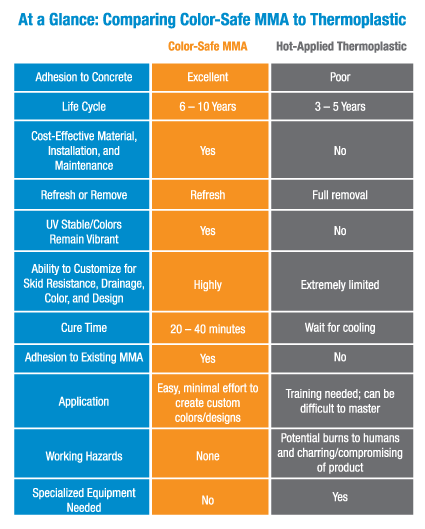
This chart sums it up: Color-Safe® is manufactured for superior quality, performance, and reliability and delivers that by providing a more cost-effective, durable, vibrant, customizable, and safer pavement marking solution for you and your crews.
There’s more to this discussion that is covered in our comprehensive eBook, “Why Choose Color-Safe MMA over Thermoplastic?” Curious about the problems thermoplastic can cause you for your next pavement marking installation … and how to avoid them with Color-Safe? Download it now to find out.
3 Things DPW and Transportation Professionals Should Know about Bus and Bike Lanes
Color-Safe Pavement Markings Keeping Commuters and Cyclist Safe
Many cities in the U.S. are expanding their portfolios of bicycle lanes and bus-only lanes. Creating bus lanes helps to alleviate congestion in heavily travelled areas by the decreasing the number of cars traveling in those spaces, especially during peak times. In fact, worldwide, many countries are implementing bus rapid transit (BRT) systems, which can reduce travel time and commuter impact by millions of hours.
Bike lanes reduce the rate of injury to cyclists by 50%. Clearly marked bike lanes help motorists to more accurately gauge the space to allow for cyclist (not doing so accurately causes accidents, to either cyclist or motorist swerving to over-correct, accordingly to a study in three cities in Texas.)
Let’s break this down a bit further with three basic concepts that transportation professionals should keep in mind when planning for these dedicated rights-of-way.
1) Dedicated Lanes Move More People
By denying access to the road users who take up the most space per person (that’s you, drivers), dedicated lanes can actually provide transportation to more people in less time. It’s not difficult to imagine how a bus-only lane with frequent, full buses is going to move a lot more people than a congested lane of traffic. Bike lanes, by virtue of how narrow they are, provide a lot of throughput in exchange for relatively little road space. Furthermore, the improvement in travel times for bus riders or bicyclists makes those options more attractive, which can help get drivers off the road and decrease congestion in other parts of the road network.
That’s a lot of benefit, especially when you consider that:
2) Constructing Dedicated Lanes is Easy
Dedicated bike and bus lanes are not major capital investments. Often, they can be installed with nothing more than a coat of Color-Safe™ durable pavement marking material, vibrant, colorfast road markings, and a little signage. In the case of bike lanes, they can often be installed without even reducing the number of lanes of vehicular traffic.
However, Departments of Transportation often treat new bus and bicycle infrastructure like major projects, with all the red tape that goes with. Some agencies have gotten around this by treating the installation of dedicated lanes as routine maintenance rather than new construction. Assigning the project to DPW may help state and municipal governments find the needed funding. This workaround, or other means of streamlining the pre-construction process, may have the potential to accelerate the buildout of dedicated networks of bike and bus lanes.
And that’s important, because:
3) Networks Work
A central goal of transportation planning is to maximize the number of users who will benefit from investments in infrastructure. A single bike lane or rapid bus route—made possible by a dedicated lane—does very little to advance this goal, because most destinations are still going to be out of reach for most users. However, the value of a bike lane grows exponentially with each connection to another bike lane. The value of a dedicated bus lane, meanwhile, is a function of the number of routes it serves and the connections to other routes. (Note the BRT systems mentioned above being implemented around the world!)
A famous example in the cycling world is Portland, Oregon, where an entire bike lane system crisscrosses the whole city and cycling rates are among the highest in the country.
There is no question about the safety benefits of bicycle and bus lanes, and adding the efficiency of moving traffic, and of the “green” or sustainability factor, municipal and government transportation need to consider the most economical means of funding dedicated lanes. Color-Safe MMA is a cost-effective pavement marking material. Take a look at our Color-Safe portfolio and see the many solutions our experts in transportation and safety at Transpo Industries have installed for towns, cities, and airfields. Download it now and see if your solution is one just click away.
Transpo® Industries at Savannah Hilton Head International Airport
This past summer Transpo® Industries was proud to work with the Savannah Hilton Head International Airport in installing Color-Safe Methyl Methacrylate (MMA) airfield pavement markings. This unique yellow Color-Safe Taxiway Echo “Hold Short” Bar application is complete with glass beads to help maximize the color’s brilliance. Transpo Industries has been providing airports with this top MMA resin for years as officials need materials that put safety first; for this Color-Safe’s anti-skid high friction surface treatment, with an impressive record of reducing fatalities, is always a go-to solution.
Transpo® Industries is Makings Tracks in Wisconsin
This summer the Wisconsin Department of Transportation (WDOT) and Transpo® Industries joined forces to install the railway pavement marking dynamic envelope as well as Transpo®'s Bodan Highway-Rail Grade Crossing Surface. The new installation took place on a 76 foot crossing in Stiles, Wisconsin on Escanaba & Lake Superior tracks.
Bodan is a precast reinforced polymer concrete rail crossing system that was designed to withstand harsh weather conditions, as well as the wear and tear of high volume highways. This crossing featured a unique stone for the non-skid surface to help ensure maximum resistance. Additionally, since Bodan was created with the needs of the Department of Transportations in mind, it has a unique modular design that allows for easy removal, permitting easy track inspection and maintenance.
Transpo’s Color-Safe Pavement Marking for Dynamic Envelope was also implemented, a safety measure that will guarantee optimal visibility for anyone crossing. Color-Safe has already been well established as a durable pavement marking that can withstand the harshest of conditions, but there is still another value that was particularly important in the project: maximum brightness. The Color-Safe markings are the surest route to ensuring all drivers are aware they are crossing a track, and this has been proven to effectively drive down track crossing incidents time and time again.
Transpo® Industries is Heading to SASHTO's Annual Conference
Transpo® Industries has long worked with the Southern Association of State Highway and Transportation Officials (SASHTO). SASHTO was originally created to help enforce and encourage a healthy transportation system in the southern United States and has been hosting important events since.
This year, the Virginia Department of Transportation (VDOT) will be hosting the SASHTO annual conference in Norfolk, VA, from August 12th -15th. We at Transpo® Industries are excited about attending and networking with the wonderful men and women of SASHTO. This wonderful event brings together officials and professionals from across the southern United States, all of whom are dedicated to learning and sharing about news, innovations, and progress within the world of transportation.
Transpo® Industries Has a Carolinian Summer
For many years we, at Transpo® Industries, have enjoyed working with Southeast transportation safety agencies, and this summer we were able to enjoy both of the Carolinas to the fullest. The Carolinian shores are known for their seasonal splendor and we were thankful to be given the opportunity to help beautify and safeguard the roads that get people there.
Highway 70 Bypass Bridge: We joined forces with the North Carolina Department of Transportation in putting down our T-78 Polymer Crack Healer/Sealer to seal the entire bridge deck. This not only repaired existing cracks but it also ensured the bridge will stay crack-free for summers to come.
Cooper River Terminal: A bit more south, we were happy to work with the South Carolina State Ports Authority in Charleston in sealing the pass with both T-78 Polymer Crack Healer/Sealer, and installing our Color-Safe Grey pavement marking resin. The Color-Safe resin will not only protect the terminal going forward, but will also stay bright no matter the weather conditions.
Transpo® Industries Lays Permanent Paw Prints at Mississippi State University
We at Transpo® Industries are excited to announce permanent paw marks have been laid down at Mississippi State University (MSU). The university is well known for their mascot, Bully the Bulldog, and in keeping with the university’s loyal fandom they have recently added and refreshed paw marks on MSU roadways. Since MSU football has a wonderfully large following, the university officials wanted to make sure the paw print pavement markings would last for many seasons no matter how many paws marched that road to victory. With durability in mind, the Color-Safe Pavement Marking material was chosen to both replace previously fading marking and to create new markings. This ensures not only will Bully’s prints see years of wins, but will retain a bright color representative of the university’s bright team spirit.
Transpo®’s Color-Safe Splashes onto the Streets of NYC
Transpo® Industries is excited to announce our recent work in our very own New York City on the 79th Street Select Bus Service lane. The NYC Department of Transportation (NYCDOT) needed a reliable pavement marking with very specific qualities. Not only is Color-Safe a Methyl Methactylate (MMA) product, meaning it can stay bold and beautiful through harsh weather conditions, but it is also very easy to apply so NYC bus lanes were up and running in a New York minute!
The application of the Color-Safe Bus Lane Pavement Marking is part of the NYCDOT’s plan to help strengthen and further invest in the trepanation infrastructure of NYC. We, at Transpo® Industries, are proud to continuously be part of the efforts keeping our great city’s transit systems running and safe.
Transpo® Industries Paves the Way for Busses in Queens, NY
We at Transpo® Industries are proud to announce that recently the New York Department of Transportation (NYDOT) implemented our Color-Safe Bus Lane Pavement Markings on the Woodhaven Blvd bus lane in Queens, New York. As Woodhaven Blvd is known for being an enormously congested traffic area, with weather varying from heat, rain to snow, the NYDOT chose Color-Safe. Not only is Color-Safe extremely durable and long lasting, but it is easy and quick to apply. This allowed the NYDOT officials to reopen the roads as soon as it was possible, thus ensuring minimum inconvenience to the New York commuters.
This project was one in a line of many where Transpo® Industries has proudly joined with state DOTs to ensure maximum quality transportation safety materials are used on statewide projects and maintenance.
July 4th- Thanking Those Who Keep the US Moving
This July 4th, Transpo® Industries would like to take the time to thank the many Unites States transportation departments that are responsible for our nations' security and safety while we are traveling. Be it land, air or sea, there are many great US departments that work tirelessly to ensure our nation has no blocks on our roads to success. So, in the spirit of the red, white and blue holiday we would like to acknowledge the below departments and all their work.
United States Department of Transportation (USDOT)- This Department oversees most of the administrations on our list below. They report directly to Washington and were established by congress in 1966.
State US DOT- Each state has their own Department of Transportation division, and each state DOT focuses on the needs specific to their state. Some state DOT’s even have additional organizations created to suit their state’s unique needs.
National Highway Traffic Safety Administration (NHTSA)- The NHSTA’s sole purpose is to find ways to help ensure traffic safety by researching, setting and enforcing road safety regulations.
Federal Aviation Administration (FAA)- The FAA’s mission is simply to ensure US travelers have the most secure, and the most operative, air travel system in the world.
Federal Highway Administration (FHWA)- The FHWA oversees the planning, creation and preservation of the US’ highways, bridges and tunnels. They also undertake research projects to learn about new and innovative road safety measures.
Federal Motor Carrier Safety Administration (FMCSA)- One of the lessor known, but not lesser important, administrations is the FMCSA who work to reduce and prevent accidents, fatalities and damages related to commercial motor vehicles.
Federal Railroad Administration (FRA)- The FRA oversees and ensures the safety of people, animals and goods traveling on or near the US railways.
Federal Transit Administration (FTA)- Like the FMCSA, this administration does not see as much limelight in the news, however they are probably one of the most important administrations as they run and oversee all the US public transit systems. That includes buses, subways, commuter rails, trolleys, light rails, tramways and even ferries.
Maritime Administration (MARAD)- As it’s name would suggest, the MARAD is charged with stewardship of all waterborne transportation, and given the expansive coastlines and waterways within the United States that is a colossal undertaking.
Transportation Security Administration (TSA)- This is probably the most well-known on our list, the TSA’s mission is best stated on their about us page, “… to protect the nation's transportation systems to ensure freedom of movement.”
National Transportation Safety Board (NTSB) - The NTSB is an amazing and unique board that is tasked with investigating and researching causes and prevention of transportation accidents. They also do amazing work helping the victims of accidents and their families.
For more information regarding the Color-Safe materials used in creating the flag in the image above please visit the Transpo® Pavement Markings Page. Thank you.


